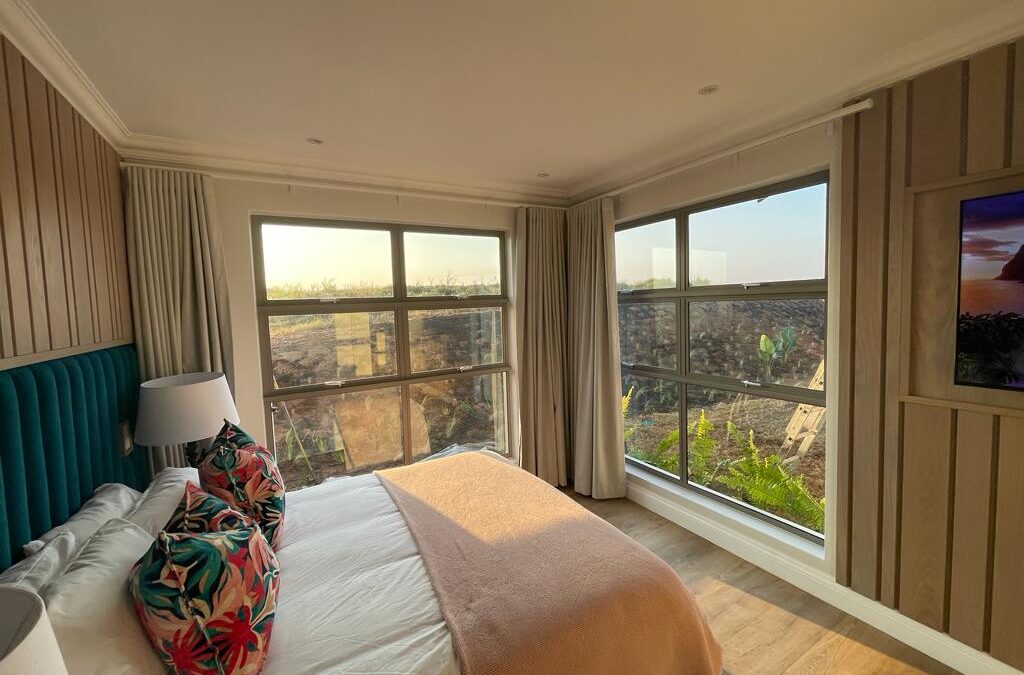Appearance
Because of the present-day trend to simplify the exterior appearance of houses by eliminating unnecessary and costly decoration, architectural expression in houses is obtained to a large degree by the relationship of window areas to solid wall areas. The number and placement of windows, and even the type of windows, affect the architectural character of the house.
 |
 |
| Unrelated glass and wall areas | Pleasing relationship between glass and wall areas |
While windows must first be selected, sized and located to satisfy interior requirements, minor adjustments in size and/or location may be necessary to provide an acceptable appearance on the exterior of the house. Windows should also be used so that the building exterior gives an appearance of continuity, rather than one of unrelated glass and wall areas.
Privacy
Use of large glass areas usually requires some controls for privacy, both in the daytime and at night. Obvious controls include draperies and blinds. Consideration must be given to the size and the placement of these hangings so that they do not cancel the benefits of breeze. The use of louvres or other opaque types of ventilating units which do not have to be draped is one solution to this problem of privacy with ventilation. Placing windows high in the wall is another effective means of obtaining privacy, especially in bedrooms.
 |
| Even though the glass area is large, the occupants of the house can have privacy. |
Design
In planning for windows, consider the use of large glass areas not only in the living room but in any room of the house that can benefit from increased daylight, view, or heat gain from the sun. On the other hand, small window areas may serve several purposes well. A bedroom on a western exposure, for example, may employ a series of short, high windows that supply daylight, provide privacy, and yet keep the glass area on this exposure to a minimum so that the rays of the sun are not objectionable.
Often a combination of window types is best suited for both interior requirements and exterior appearances. The use of fixed glass with one or more operating window units achieves a functional window which also has a pleasing architectural character.
Such units permit:
- The head of the window to be placed high in the wall for daylight
- The sill of the opening section of the window to be placed high in the wall – the best location for natural air movement
- The middle half of the wall to be left unobstructed for view
Light
To ensure even distribution of the greatest amount of daylight within a room, consider the following tips when designing your home:
- Provide glass areas in excess of 20% of the floor area of each room. This is a general rule of thumb. Most building codes recommend that the glass area be not less than 10%, but much more is desirable to meet daylight requirements on cloudy days. On brighter days, the amount of light can be controlled by interior and exterior shading devices.
- Place the main window area toward the north, except in hot climates where a southern orientation is favoured in order to limit heat from the sun. The north sky is considerably brighter than the south sky. A northern exposure permits the maximum amount of daylight and also the greatest amount of solar heat in winter.
- Group window openings in the wall to eliminate undesirable contrast in brightness. Provide one large opening on a wall instead of several small ones to do away with dark areas between openings.
- Select the window shape that gives the desired distribution of light within each room. For a broad, shallow distribution of light, use short, wide windows. Tall, narrow windows give a thin, deep distribution of light. Intensity of light is great near the window and then drops off rapidly and smoothly within a short distance.
- Place the window as high in the wall as possible to lengthen the depth of light penetration into the room. If possible, place the top of the window close to the ceiling. More sky is visible through the upper parts of the window than the lower, moreover, the overhead sky is brighterthan the sky at the horizon.
- Use windows in more than one wall for greater admission and better distribution of daylight.
- Do not specify corner windows or bay windows as a means to increase the daylight effectiveness of the window. The actual area of glass is greater and more costly than the effective daylight area obtained.
- Screen only those parts of the window that open for entilation. Full screens on a double hung window can absorb as much as 50% of the available daylight. Half screens absorb only 15%.
- Finish ceilings and walls (and even the floor if practical) in light colours to take advantage of light distribution made possible by reflection. Use flat or dull finishes. Furnishings, especially curtains, should also be light in colour.
- Mount curtains, shades and other window hangings above the top of the window and to the side of the window frame, in order to free the entire glass area and thus admit the greatest amount of light. Dark, heavy curtains hung over the sides and top of a window can reduce the available daylight. The practice of pulling window shades one-fourth ;or one-half of the way down results in loss of light at the rear of the room where it is most needed.
Ventilation
Natural ventilation of a house is primarily a summer problem – one of comfort. The number, size, and placement of ventilation openings are all important elements in planning windows for ventilation. The effectiveness of windows in achieving desired ventilation depends also on which windows are opened and on how far they are opened.The difficulty in using a window for both admission of light and air is that its size and location for the best day lighting often conflict with the size and location which produce the best ventilation.
The principles of air movement as applied to houses are:
- Air moves because of differences in temperature or differences in pressure. In single storey homes, the movement of air because of differences in temperature is negligible. The placement of windows in these homes therefore, should be governed by movement of air due to pressure differences.
- A high pressure area is created when air strikes a building. Low pressure areas are created as the air moves over and around the building. Air flows into a home through openings in the wall against which the wind blows. The wall acts as a dam, causing the air pressure to build up. Air flows out of a home because of differences in pressure. It moves from high pressure areas inside the home, through openings to areas of lower pressure outside the home.
- To speed the movement of air within a room, the openings through which the air leaves the home should be larger than those through which it enters. Obstacles in the path of moving air cause it to change direction, thus slowing it down, i.e. trees, shrubbery or fences on the outside; partitions, walls, or furniture on the inside. Because the cooling effect of air in summer depends on its speed, obstructions which slow the movement of air should be kept to a minimum.
- The angle at which the air enters and leaves the room is the controlling influence on the pattern of air movement within the home. This angle depends on the location and type of window. Refer to the following tips to select and locate windows for the best ventilation.
- Provide ventilation openings in excess of 10% of the floor area of a room. This is a general rule of thumb. Most building codes have established minimums of 4-5% of the floor area, but just as large glass areas provide daylight for cloudy days, sufficient ventilation openings can offer relief on warm, sultry days.
- Locate the house and the ventilation openings to take full advantage of prevailing breezes. Do this by determining the high and low pressure areas as defined by the shape of the house – the walls which the breeze will strike and the walls around which the air moves. Allow for changing wind directions.
- Locate windows so as to effect the best movement of air across the room and within the level that occupants sit and stand. Do this by placing windows away from exterior corners and placing horizontal sliding, casement and awning windows in the lower part of the wall since these window styles cannot direct the movement of air downward.
- Plan landscaping, interior partitions, and furniture so they do not interfere with air movement. If possible, place the house so that existing buildings and hills do not divert the wind away from the house. Avoid setting trees, shrubbery and fences in the path of the breeze.
View
Being able to see through windows is as important to occupants of a home as the admission of daylight and air. Sometimes the house is placed on a lot to command a picturesque landscape scene; sometimes the home owner finds it necessary to create a pleasant view to hide a less desirable one e.g. a planted area to hide an alley. Large glass areas extend indoor space outward, making outdoor living areas an integral part of the home.Problems in window placement may arise when a house is set on the lot to command a natural view on the east or west, since it is difficult to shade the occupants’ eyes from the sun early or late in the day. Devices to keep the sun’s rays away from the windows may obstruct the view. View windows on the north can be protected from the sun’s rays by a roof overhang, and those on the south are not bothered by the sun.
The glare of the sun on an east-west orientation for a view located within the boundaries of a lot is not difficult to control. Fences and tall shrubbery actually define the view instead of obstructing it.
Generally the proportions of the window can be scaled to the view – a horizontal window for a panoramic view such as a mountain range; a vertical window for a confined view such as a terrace.
Consider the following tips when placing windows:
- To minimise obstructions in the line of sight, use fixed glass except in those areas where ventilation must be provided. Screens are not needed on fixed glass and therefore eliminate another interference from a standpoint of view. Windows having slight divisions are acceptable. A horizontal division more than 100mm thick is not desirable when the division falls in the line of sight. Vertical divisions not as objectionable as horizontal ones.
- Determine the height for the bottom of the window on the basis of room use and furniture arrangement.
- Horizontal window division members are undesirable when they interfere with view. Dimensions in the four sketches show the eye level range for persons standing, sitting and sitting at a table. Avoid horizontal window divisions within these eye levels. Dimensions are based on a study of:
- persons from 152cm to 193cm tall
- usual window head heights; and
- usual window sill heights as determined by furniture or airconditioning units
Aluminium Finishes
Aluminium colours are not limited and come in a huge range. Please enquire should you require a specific colour.

